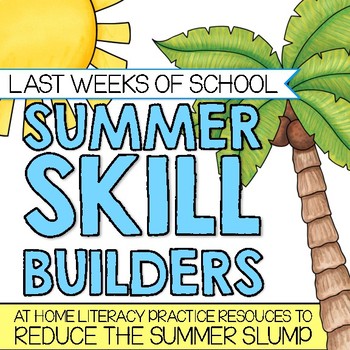Summer Skill Builders: At Home Literacy Resources for Summer
- PDF
Description
Looking for an easy way to make summer reading and writing more engaging so students can support their children in meaningful ways and reduce the summer slide? This collection of practice tools can help your students maintain the reading and writing growth made this school year so they hit the ground running when they head back to school. The open-ended nature of these literacy activities make them ideal for second graders who are moving into third grade or third graders who are moving into fourth grade.
***************************************************************************
WHAT’S INCLUDED:
★ Standards Alignment: See exactly which standards are addressed by each activity in this packet.
★ Summer-Inspired Writing Prompts: 78 unique summer-themed prompts give students the opportunity to write across the genres throughout the summer.
- 25 creative journaling prompts
- 19 informational/expository writing prompts
- 12 opinion writing prompts
- 12 personal narrative prompts
- 10 imaginary narrative prompts
★ Writing Planners: Writing planners for each genre to help your students organize their ideas before drafting their summer writing pieces. These can easily be swapped out, and replaced by the writing planners you have used in class throughout the year.
- Informational/expository writing planner
- Opinion writing planner
- Personal narrative writing planner
- Imaginary narrative writing planner
★ Writing Tip Sheets: Keep the writing process, and steps for editing & revising fresh in your students’ minds with these organized tip sheets.
★ Summer Reading Activities List: Five easy and fun ways to make the summer reading experience more engaging for your young readers. Ideas include:
- Starting a book club
- Hosting a reading party
- Building a book nook
- Reading to someone,
- Reading to self in a cozy corner, or shady spot
★ Fiction Reading Prompts: 26 open-ended comprehension questions designed to be used with any fiction book. Perfect for comprehension conversations when reading to someone, or to be used as prompts to write about reading after reading to self.
★ Nonfiction Reading Prompts: 29 open-ended comprehension questions designed to be used with any nonfiction text. Perfect for comprehension conversations when reading to someone, or to be used as prompts to write about reading after reading to self.
★ R.A.C.E. Writing Response Visual: Students can practice writing about reading by picking any of the reading prompts mentioned above, and writing a detailed answer using the R.A.C.E. approach.
***************************************************************************
WHAT TEACHERS THINK OF THIS RESOURCE:
♥ “This packet made summer review a cinch! The design is clean and the activities are meaningful. The perfect combination!” - Tanya H.
♥ “You make the best products! Thank you for putting the time and effort into making such a valuable resource :)” - Emily T.
♥ “This was the perfect packet to send home over the summer. Very engaging!” - Krystle D.
***************************************************************************
Interested in building a full collection of resources the last weeks of school? Check out these favorites:
- Index Cards and Castles - A Design Challenge and Team Building Activity
- Reading Summit - End of Year Reading Day
- The Time of Your Life: Telling Time Project Based Learning (PBL)
- Tidy Up Team: Task Cards For End of Year Classroom Clean Up
- Editable Student Portfolio Toolkit
***************************************************************************
LET'S CONNECT: ★ The Core Inspiration Blog ★ Instagram ★ Pinterest ★ Facebook ★





